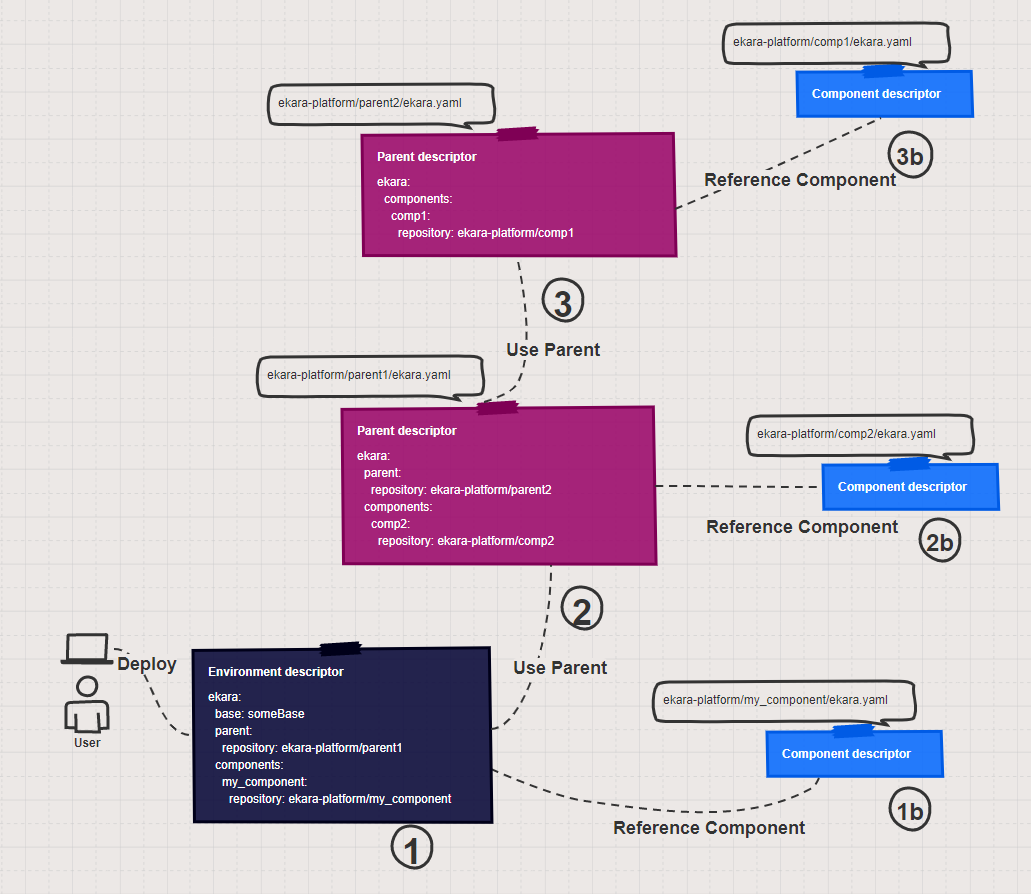Component model
Before doing any work, the Ekara engine must build a model of the environment that is worked on. This model is aggregated from multiple descriptors, located in components that must be discovered, fetched et parsed. A component:
- Lives in a source repository which is fetched dynamically when necessary.
- Can optionally contain a descriptor file, named
ekara.yamlby default.
The first component to be fetched is either specified in the command-line (in the case of a new environment) or already known (in the case of an existing environment).
Example
Consider the following components:

- The starting point of component discovery is called the main component (1).
- The main component declares a parent component (2).
- The parent itself declares its own parent component, forming an inheritance chain (3).
- At each level in the inheritance chain, additional components can also be referenced (1b, 2b, 3b).
Typically, parent components are used to regroup parameters common to set of environments. For instance, multi-level parents can be used to regroup settings in organizational layers.
Aggregation
After all components have been discovered, the effective model aggregation occurs:
- Components referenced by the top-level parent (3b) are parsed in their declaration order, defining the initial model.
- Then the top-level parent (3) is merged.
- Then components referenced by the intermediate parent (2b) are merged.
- Then the intermediate parent 2 is merged.
- Then components referenced by the main component (1b) are merged.
- Then the main component (1) is merged.
Each step can extend or override values defined in previous ones.
Declaration
To declare a component (parent or referenced), use the following attributes:
- A
repositoryattribute denoting the source repository holding component code. - A
refattribute denoting the branch, tag or commit of the component to fetch. - An
authattribute only required when authentication is required to access the source repository.
Repository
The repository attribute allows to specify the location of a component:
ekara:
components:
aPublicComponent:
repository: https://github.com/myOrganisation/my-public-rep
Currently git is the only source control management system supported for repositories.
Ref
The ref attibutes identifies the branch, tag or commit to fetch:
components:
aPublicComponent:
repository: https://github.com/myOrganisation/my-public-rep
ref: aGivenBranch
When a ref attribute is specified, Ekara will:
- Try to find a matching tag.
- If no tag is found, it will try to find a matching branch.
- If no branch is found, it will try to find a matching commit.
The default value for ref is master.
Authentication
The auth attribute specifies the authentication information required to connect to a private repository.
Example:
ekara:
components:
aPrivateComponent:
repository: https://github.com/myOrganisation/my-private-rep
auth:
method: basic
user: yourUserName
password: yourUserPassword
Currently basic is the only authentication method supported.
You can externalize data like credentials from descriptors by using templating.